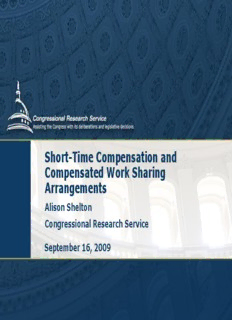
Alison M. Shelton PDF
Preview Alison M. Shelton
Short-Time Compensation and Compensated Work Sharing Arrangements Alison Shelton Congressional Research Service September 16, 2009 Agenda • What is Short-time Compensation (STC)/Compensated Work Sharing? • How Do STC Programs Work? • A Little History • Reasons Why Many States Do Not Have STC Programs CRS-2 What is Short-time Compensation, aka Compensated Work Sharing? • A firm needs to reduce its 100-person workforce temporarily by 20%. The choices are: lay off 20 workers OR reduce the work hours of the entire workforce by 20% — from five to four days a week CRS-3 What is Short-time Compensation, aka Compensated Work Sharing? (continued) • Short-time compensation (STC) is a program within the federal-state unemployment compensation system. • In the 17 states that operate STC programs, workers whose hours are reduced under a formal work sharing plan may be compensated with STC. • STC is a regular unemployment benefit that has been pro-rated for the partial work reduction. CRS-4 Some Definitions • States with STC programs require employers who seek STC for their workers to submit a formal work sharing plan for approval. • “Work sharing” refers to any arrangement under which workers’ hours are reduced in lieu of a layoff. STC may or may not be paid. • Not to be confused with: Partial Unemployment Benefits CRS-5 Example • A firm temporarily reduces the work hours of its entire workforce by 20% – from five to four days a week. • Work sharing employees receive about 90% of their full-time wages as compensation for four days of work: 80% as wages plus 10% as STC. • Unemployment benefits generally replace about half of a worker’s wages (with variation among states). • STC benefits for a worker who has experienced a 20% reduction in hours would amount to about 10% of the worker’s wages before the reduction in hours. CRS-6 How Do STC Programs Work? • Employer develops a formal work sharing plan and submits it for approval to the relevant state agency. • Employer certifies that the reduction in work hours is in lieu of temporary layoffs. • If the workforce is covered by a collective bargaining agreement then states generally require that the relevant union(s) consent to the employer’s plan. • STC benefits are financed through experience-rated state unemployment taxes on employers. CRS-7 Employees • All states require eligible STC beneficiaries to have had their workweeks reduced by 10% or more. • Eligible employees are not required to meet the “able and available for work” requirement, but must be available for their normal workweek. • Eligible employees may participate in an employer-sponsored training program. • In a typical program, workers will retain their employer-provided health and retirement benefits as if they continued to work a full week. CRS-8 Regulatory Framework • Many of these programmatic elements are not required by the 1992 law that permanently authorized the STC program. • Instead, states retain these features from a temporary STC program that Congress authorized from 1982 to 1985. • USDOL oversees the STC program as part of the larger federal-state unemployment compensation system. CRS-9 A Little History • In the 1930s, Herbert Hoover encouraged work sharing. • In 1975, New York was the first state to consider STC legislation as part of a broader employment policy bill that died in committee. • In 1978, California became the first state to enact an STC law. • From 1982-1985, the federal government introduced a temporary, national STC program with the Tax Equity and Fiscal Responsibility Act (TEFRA, P.L. 97-248). • In 1992, Congress enacted permanent STC legislation, the Unemployment Compensation Amendments of 1992 (UCA, P.L. 102-318). CRS-10
Description: